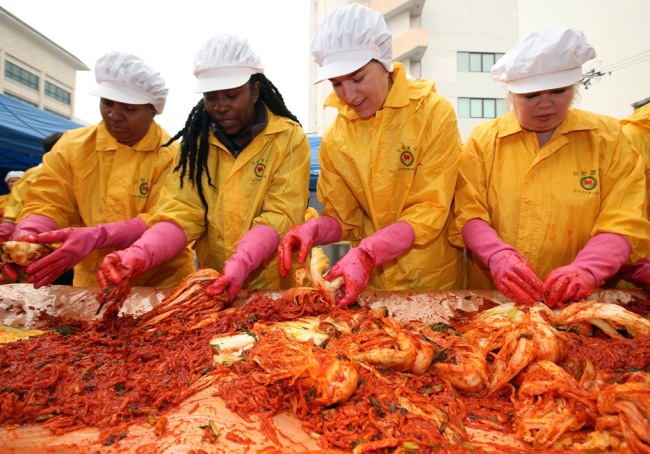
Kimjang, the tradition of making and sharing of kimchi that usually takes place in winter, was added to the UNESCO Intangible Cultural Heritage of Humanity list on Thursday.
The listing will allow Korea to not only preserve the annual household tradition and the community spirit that goes with it but also to promote kimchi on a global scale.
The Intergovernmental Committee for the Safeguarding of Intangible Cultural Heritage made the decision during the UNESCO general assembly at Baku, Azerbaijan, from Dec. 2-7, upholding a subsidiary body’s recommendation made in October.
According to the committee, kimjang has “voluntarily” been passed through the generations and represents the communal spirit of Koreans in winter, solidifying their Korean identity.
“Kimjang” refers to the process of preparing large vats of spiced and fermented cabbage and other vegetables with a large gathering of family, friends or community members before the start of winter and storing the kimchi vats underground for fermentation. It has long been an essential part of preparing for the long winter when fresh vegetables are not readily available.
Experts expect the designation will secure kimjang a firm place in Koreans’ lives as the rather long and labor-intensive process is rapidly being replaced by purchasing kimchi produced in factories.
“Kimjang involves preserving different kimchi-making processes and the flavorings of different families. It also shows the ‘jeong’ spirit of affection and caring, something that the Korean communities have preserved for a long time,” said Park Sang-mi, a professor at Hankuk University of Foreign Studies and a member of the preparation committee for the kimjang designation.
According to the Cultural Heritage Administration’s 2011 survey, about 95 percent of Koreans eat kimchi more than once a day and 64 percent prefer kimchi with all three meals of the day. It also showed that 80 percent of Koreans make kimchi themselves or participate in the kimchi-making process in various ways, including assisting their kin with kimjang.
“Foreigners may know about kimchi but they do not know about kimjang. When we unveil kimchi to the world, telling stories about the making of kimchi will make things more appealing,” said Park Jong-chul, director at the Kimchi Institute at Suncheon National University.
With kimjang’s designation, Korea now has 16 items on UNESCO’s Intangible Cultural Heritage of Humanity List, including the Royal Ancestral Rites and Ritual Music at the Jongmyo Shrine, which was performed at memorial ceremonies during the Joseon era; “pansori,” a traditional Korean style of narrative song; falcon hunting and the traditional folk song of “Arirang.”
By Bae Ji-sook (baejisook@heraldcorp.com)
-
Articles by Korea Herald




![[Herald Interview] 'Amid aging population, Korea to invite more young professionals from overseas'](http://res.heraldm.com/phpwas/restmb_idxmake.php?idx=644&simg=/content/image/2024/04/24/20240424050844_0.jpg&u=20240424200058)













![[KH Explains] Korean shipbuilding stocks rally: Real growth or bubble?](http://res.heraldm.com/phpwas/restmb_idxmake.php?idx=652&simg=/content/image/2024/04/25/20240425050656_0.jpg&u=)

